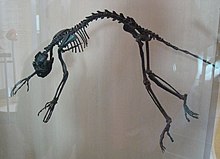

The evolutionary history of the primates can be traced back 57-90 million years.[1] One of the oldest known primate-like mammal species, Plesiadapis, came from North America;[2] another, Archicebus, came from China.[3] Other similar basal primates were widespread in Eurasia and Africa during the tropical conditions of the Paleocene and Eocene. Purgatorius is the genus of the four extinct species believed to be the earliest example of a primate or a proto-primate, a primatomorph precursor to the Plesiadapiformes, dating to as old as 66 million years ago.
The surviving tropical population of primates, which is seen most completely in the upper Eocene and lowermost Oligocene fossil beds of the Faiyum depression southwest of Cairo, gave rise to all living species—lemurs of Madagascar, lorises of Southeast Asia, galagos or "bush babies" of Africa, and the anthropoids: platyrrhine or New World monkeys, catarrhines or Old World monkeys, and the apes, including Homo sapiens.
- ^ Maxwell 1984, p. 296
- Rui Zhang; Yin-Qiu Wang; Bing Su (July 2008). "Molecular Evolution of a Primate-Specific microRNA Family". Molecular Biology and Evolution. 25 (7). Oxford, UK: Oxford University Press on behalf of the Society for Molecular Biology and Evolution: 1493–1502. doi:10.1093/molbev/msn094. PMID 18417486.
- Willoughby, Pamela R. (2005). "Palaeoanthropology and the Evolutionary Place of Humans in Nature". International Journal of Comparative Psychology. 18 (1). International Society for Comparative Psychology: 60–91. doi:10.46867/IJCP.2005.18.01.02.
- Martin 2001, pp. 12032–12038
- Tavaré, Simon; Marshall, Charles R.; Will, Oliver; et al. (April 18, 2002). "Using the fossil record to estimate the age of the last common ancestor of extant primates". Nature. 416 (6882). London: Nature Publishing Group: 726–729. Bibcode:2002Natur.416..726T. doi:10.1038/416726a. PMID 11961552.
- ^ Rose, Kenneth D. (1994). "The earliest primates". Evolutionary Anthropology: Issues, News, and Reviews. 3 (5). Hoboken, NJ: John Wiley & Sons: 159–173. doi:10.1002/evan.1360030505.
- Fleagle, John; Gilbert, Chris (2011). Rowe, Noel; Myers, Marc (eds.). "Primate Evolution". All The World's Primates. Charlestown, RI: Primate Conservation, Inc. Retrieved 2015-04-27.
- Roach, John (March 3, 2008). "Oldest Primate Fossil in North America Discovered". National Geographic News. Washington, D.C.: National Geographic Society. Retrieved 2015-04-27.
- McMains, Vanessa (December 5, 2011). "Found in Wyoming: New fossils of oldest American primate". The Gazette. Baltimore, MD: Johns Hopkins University. Retrieved 2015-04-27.
- Caldwell, Sara B. (May 19, 2009). "Missing link found, early primate fossil 47 million years old". Digital Journal. Toronto, Canada: digitaljournal.com. Archived from the original on 22 May 2009. Retrieved 2015-04-27.
- Watts, Alex (May 20, 2009). "Scientists Unveil Missing Link In Evolution". Sky News Online. London: BSkyB. Archived from the original on 2011-07-28. Retrieved 2015-04-27.
- ^ Wilford, J. N. (June 5, 2013). "Palm-size fossil resets primates' clock, scientists say". The New York Times. Retrieved June 5, 2013.